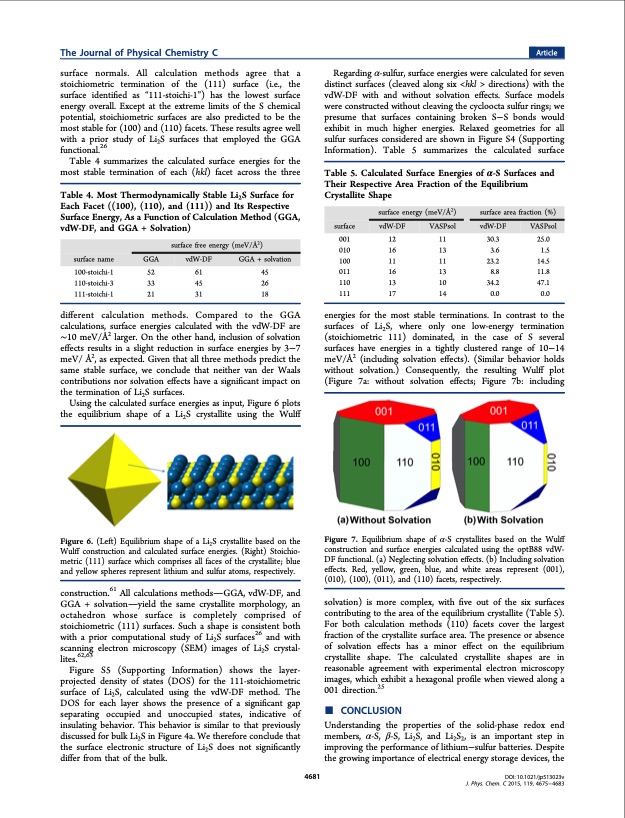directions) with the vdW-DF with and without solvation effects. Surface models were constructed without cleaving the cycloocta sulfur rings; we presume that surfaces containing broken S−S bonds would exhibit in much higher energies. Relaxed geometries for all sulfur surfaces considered are shown in Figure S4 (Supporting Information). Table 5 summarizes the calculated surface
Table 5. Calculated Surface Energies of α-S Surfaces and Their Respective Area Fraction of the Equilibrium Crystallite Shape
surface energy (meV/Å2) surface area fraction (%)
surface vdW-DF
VASPsol vdW-DF VASPsol
surface free energy (meV/Å2)
surface name GGA vdW-DF GGA + solvation
100-stoichi-1 110-stoichi-3 111-stoichi-1
52 61 33 45 21 31
45 26 18
001 12 010 16 100 11 011 16 110 13 111 17
11 30.3 25.0 13 3.6 1.5 11 23.2 14.5 13 8.8 11.8 10 34.2 47.1 14 0.0 0.0
different calculation methods. Compared to the GGA calculations, surface energies calculated with the vdW-DF are ∼10 meV/Å2 larger. On the other hand, inclusion of solvation effects results in a slight reduction in surface energies by 3−7 meV/ Å2, as expected. Given that all three methods predict the same stable surface, we conclude that neither van der Waals contributions nor solvation effects have a significant impact on the termination of Li2S surfaces.
Using the calculated surface energies as input, Figure 6 plots the equilibrium shape of a Li2S crystallite using the Wulff
Figure 6. (Left) Equilibrium shape of a Li2S crystallite based on the Wulff construction and calculated surface energies. (Right) Stoichio- metric (111) surface which comprises all faces of the crystallite; blue and yellow spheres represent lithium and sulfur atoms, respectively.
construction.61 All calculations methodsGGA, vdW-DF, and GGA + solvationyield the same crystallite morphology, an octahedron whose surface is completely comprised of stoichiometric (111) surfaces. Such a shape is consistent both with a prior computational study of Li2S surfaces26 and with scanning electron microscopy (SEM) images of Li2S crystal- lites.62,63
Figure S5 (Supporting Information) shows the layer- projected density of states (DOS) for the 111-stoichiometric surface of Li2S, calculated using the vdW-DF method. The DOS for each layer shows the presence of a significant gap separating occupied and unoccupied states, indicative of insulating behavior. This behavior is similar to that previously discussed for bulk Li2S in Figure 4a. We therefore conclude that the surface electronic structure of Li2S does not significantly differ from that of the bulk.
4681
energies for the most stable terminations. In contrast to the surfaces of Li2S, where only one low-energy termination (stoichiometric 111) dominated, in the case of S several surfaces have energies in a tightly clustered range of 10−14 meV/Å2 (including solvation effects). (Similar behavior holds without solvation.) Consequently, the resulting Wulff plot (Figure 7a: without solvation effects; Figure 7b: including
Figure 7. Equilibrium shape of α-S crystallites based on the Wulff construction and surface energies calculated using the optB88 vdW- DF functional. (a) Neglecting solvation effects. (b) Including solvation effects. Red, yellow, green, blue, and white areas represent (001), (010), (100), (011), and (110) facets, respectively.
solvation) is more complex, with five out of the six surfaces contributing to the area of the equilibrium crystallite (Table 5). For both calculation methods (110) facets cover the largest fraction of the crystallite surface area. The presence or absence of solvation effects has a minor effect on the equilibrium crystallite shape. The calculated crystallite shapes are in reasonable agreement with experimental electron microscopy images, which exhibit a hexagonal profile when viewed along a ■001 direction.25
CONCLUSION
Understanding the properties of the solid-phase redox end members, α-S, β-S, Li2S, and Li2S2, is an important step in improving the performance of lithium−sulfur batteries. Despite the growing importance of electrical energy storage devices, the
DOI: 10.1021/jp513023v J. Phys. Chem. C 2015, 119, 4675−4683
PDF Image | First-Principles Study of Redox End Members in Lithium Sulfur

PDF Search Title:
First-Principles Study of Redox End Members in Lithium Sulfur
Original File Name Searched:
JPCC_Li-S.pdf
DIY PDF Search: Google It | Yahoo | Bing
Sulfur Deposition on Carbon Nanofibers using Supercritical CO2 Sulfur Deposition on Carbon Nanofibers using Supercritical CO2. Gamma sulfur also known as mother of pearl sulfur and nacreous sulfur... More Info
CO2 Organic Rankine Cycle Experimenter Platform The supercritical CO2 phase change system is both a heat pump and organic rankine cycle which can be used for those purposes and as a supercritical extractor for advanced subcritical and supercritical extraction technology. Uses include producing nanoparticles, precious metal CO2 extraction, lithium battery recycling, and other applications... More Info

